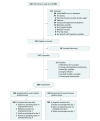Effect of Depth of Sedation in Older Patients Undergoing Hip Fracture Repair on Postoperative Delirium: The STRIDE Randomized Clinical Trial
- PMID: 30090923
- PMCID: PMC6583071
- DOI: 10.1001/jamasurg.2018.2602
Effect of Depth of Sedation in Older Patients Undergoing Hip Fracture Repair on Postoperative Delirium: The STRIDE Randomized Clinical Trial
Abstract
Importance: Postoperative delirium is the most common complication following major surgery in older patients. Intraoperative sedation levels are a possible modifiable risk factor for postoperative delirium.
Objective: To determine whether limiting sedation levels during spinal anesthesia reduces incident delirium overall.
Design, setting, and participants: This double-blind randomized clinical trial (A Strategy to Reduce the Incidence of Postoperative Delirum in Elderly Patients [STRIDE]) was conducted from November 18, 2011, to May 19, 2016, at a single academic medical center and included a consecutive sample of older patients (≥65 years) who were undergoing nonelective hip fracture repair with spinal anesthesia and propofol sedation. Patients were excluded for preoperative delirium or severe dementia. Of 538 hip fractures screened, 225 patients (41.8%) were eligible, 10 (1.9%) declined participation, 15 (2.8%) became ineligible between the time of consent and surgery, and 200 (37.2%) were randomized. The follow-up included postoperative days 1 to 5 or until hospital discharge.
Interventions: Heavier (modified observer's assessment of sedation score of 0-2) or lighter (observer's assessment of sedation score of 3-5) propofol sedation levels intraoperatively.
Main outcomes and measures: Delirium on postoperative days 1 to 5 or until hospital discharge determined via consensus panel using Diagnostic and Statistical Manual of Mental Disorders (Fourth Edition, Text Revision) criteria. The incidence of delirium was compared between intervention groups with and without stratification by the Charlson comorbidity index (CCI).
Results: Of 200 participants, the mean (SD) age was 82 (8) years, 146 (73%) were women, 194 (97%) were white, and the mean (SD) CCI was 1.5 (1.8). One hundred participants each were randomized to receive lighter sedation levels or heavier sedation levels. A good separation of intraoperative sedation levels was confirmed by multiple indices. The overall incident delirium risk was 36.5% (n = 73) and 39% (n = 39) vs 34% (n = 34) in heavier and lighter sedation groups, respectively (P = .46). Intention-to-treat analyses indicated no statistically significant difference between groups in the risk of incident delirium (log-rank test χ2, 0.46; P = .46). However, in a prespecified subgroup analysis, when stratified by CCI, sedation levels did effect the delirium risk (P for interaction = .04); in low comorbid states (CCI = 0), heavier vs lighter sedation levels doubled the risk of delirium (hazard ratio, 2.3; 95% CI, 1.1- 4.9). The level of sedation did not affect delirium risk with a CCI of more than 0.
Conclusions and relevance: In the primary analysis, limiting the level of sedation provided no significant benefit in reducing incident delirium. However, in a prespecified subgroup analysis, lighter sedation levels benefitted reducing postoperative delirium for persons with a CCI of 0.
Trial registration: clinicaltrials.gov Identifier: NCT00590707.
Conflict of interest statement
Figures



Comment in
-
Depth of Propofol Sedation and Postoperative Delirium: The Jury Is Still Out.JAMA Surg. 2018 Nov 1;153(11):996. doi: 10.1001/jamasurg.2018.2618. JAMA Surg. 2018. PMID: 30090922 No abstract available.
-
Postoperative Delirium-Amplifying the Confusion.JAMA Surg. 2019 Apr 1;154(4):366. doi: 10.1001/jamasurg.2018.5244. JAMA Surg. 2019. PMID: 30649140 No abstract available.
-
Postoperative Delirium-Amplifying the Confusion-Reply.JAMA Surg. 2019 Apr 1;154(4):366. doi: 10.1001/jamasurg.2018.5245. JAMA Surg. 2019. PMID: 30649143 No abstract available.
-
[Influence of EEG-guided administration of anesthesia on postoperative delirium in older patients].Anaesthesist. 2019 Jul;68(7):483-484. doi: 10.1007/s00101-019-0624-9. Anaesthesist. 2019. PMID: 31286162 German. No abstract available.
References
Publication types
MeSH terms
Substances
Associated data
Grants and funding
LinkOut - more resources
Full Text Sources
Other Literature Sources
Medical

